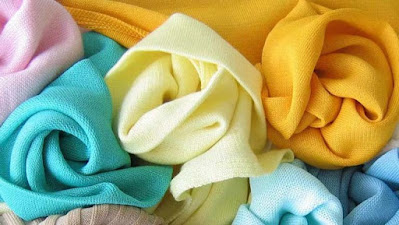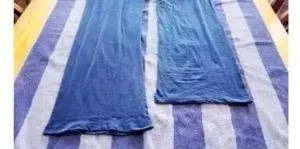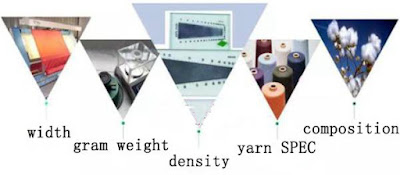Basic Knowledge and Common Dyestuffs of Textile Dyeing
Textile dyeing is an essential process for textile processing. Mastering the basic knowledge of textile dyeing and understanding the properties and of common dyestuffs and dyeing methods can help us to select and use dyestuff reasonably, develop the dyeing process correctly for dyeing processing and obtain high-quality dyed textiles.
Textile Dyeing Basics
1 What is textile dyeing?
Textile dyeing is the process of dyeing textiles products into colored objects by using physical or chemical methods to allow dyes to bond with fibers. Dyeing requirements: uniform dyeing with good color fastness.
2 Dyeing principle: color properties of dyes
Dyes have chromophore and auxochrome in their molecular structure, which selectively absorb visible light. When the chromophore and the auxochrome are different, the dyes absorb light differently, and therefore, different dyes have different colors.
In addition to differences in hue, the colors of dyes also differ in brightness and saturation. Hue indicates the type of color and depends on the state of absorption of visible light by the dye molecules. Brightness reflects the degree of brightness perceived by the human eye and depends on the reflectance of the dye molecules to incident light. Saturation is equivalent to purity and indicates the magnitude of the ratio between colored and non-colored colors at the same brightness.
Although there are many kinds of colors of dyes, the most basic tricolor are cyan, magenta and yellow, i.e. any color can be obtained by mixing the tricolor in a certain ratio with appropriate proportions. In production, the method of visual color discrimination is often used to repeatedly test color matching. In recent years, the technology of computer color matching system has been increasingly widely used.
3 The three stages of dyeing
Absorbing
The dyestuff is adsorbed by the fibers in solution due to intermolecular forces and electrostatic gravitational forces between ions.
Diffusing and penetreating
The adsorbed dyestuff diffuses and penetrates from the fiber surface to the fiber interior under certain conditions until the concentration of dyestuff reaches equilibrium in the dye solution, on the fiber surface and inside the fiber.
Fixing
The dye entering the amorphous region of the fiber is connected to the fiber macromolecules by chemical forces (ionic or covalent bonds) intermolecular gravitational forces (van der Waals forces) and hydrogen bonds to obtain a certain dyeing fastness.
In the actual dyeing process, the above three stages cannot be clearly distinguished. For different dyestuffs, different fibers and different dyeing processes, the dyeing process is also different.
4 Terms related to dye
Affinity
When a certain dye can automatically dye fiber in solution, we say that the dye has an affinity or directness for this fiber. The faster the dyeing velocity and the higher the percentage of the dye, the higher the affinity or directness, which indicates the size of the dyeing ability.
Dye strike rate
When the dyeing reaches equilibrium, the ratio of the amount of dye that has been dyed on the fiber to the amount of dye originally present in the dye solution, often expressed as a percentage, is called the dye strike rate.
Dyeing velocity
The rate at which the fibers absorb the dye and dye the color, dyeing too fast, easy to cause uneven dyeing, dyeing too slow, will prolong the dyeing time.
Dye migration
Dye migration refers to the ability of a dye that has been adsorbed by the fiber to desorb from the fiber, re-enter the dye solution, and then dye other parts of the fiber. Dyestuff with good dye migration can continuously desorb from places with high dye concentration and dye in places with low concentration until the concentration difference disappears throughout the fabric, thus achieving uniform dyeing.
Color fastness
After dyeing, textiles are constantly subjected to various external factors during use or processing, which will result in different degrees of fading, and the ability of textiles to resist fading is expressed by color fastness or dyeing fastness. If you want to know more about color fastness, please refer to this article: Color Fastness: The Ultimate Guide
5 Dyeing equipment
According to the different dyeing objects, dyeing equipment can be divided into fiber dyeing equipment, yarn dyeing equipment and fabric dyeing equipment.
According to the different dyeing temperature and pressure, dyeing equipment can be divided into atmospheric pressure dyeing equipment and high temperature and high pressure dyeing equipment.
According to the different dyeing methods, the dyeing equipment can be divided into dip dyeing equipment and pad dyeing equipment.
Lab dyeing machine for improving production and operation efficiency quickly, which is conveniently.
Dyeing properties and dyeing methods of common dyestuffs
According to the different forms of textiles, there are various dyeing processes such as fabric dyeing, yarn dyeing, fiber dyeing and garment dyeing, etc. The most common application is fabric dyeing.
Dyeing is mainly divided into two methods: dip dyeing and pad dyeing. Dip dyeing is to impregnate the textile in the dyeing solution, so that the dyeing solution is in constant contact with the textile to complete the dyeing process. This dyeing method is used for fibers, yarns, small batches of fabrics and garments. Pad dyeing is suitable for continuous dyeing processing of high-volume fabrics. When dyeing, the fabric is first impregnated with the dye solution for a short time, and then the dye solution is rolled evenly into the inside of the fabric by pressing the rollers, and then the dye is fixed on the fiber by steam or high-temperature baking.
The color of the dyed products should match with the standard sample or the sample from customers, and should be uniform and have good color fastness. The quality of textile dyeing is related to many factors, including fiber type, dyestuff characteristics, dyeing method, dyeing process conditions and dyeing equipment. Only on the basis of mastering the nature of fiber and dyestuff, choosing suitable equipment and process, and strictly controlling the conditions, can we obtain dyeing products with color compound requirements, uniform color and sufficient color fastness.
1 Dyeing properties and dye types of common dyestuffs
| types | properties | applicable fibers | color fastness | ||
| light | washing | dry rubbing | |||
| direct dyestuff | water soluble non-bright-color | cotton, hemp, viscose, copper ammonia, silk, polyvinyl acetals | poor / good | poor | good |
| acid dyestuff | water soluble bright color | wool, silk, nylon | poor / good | poor / good | good |
| cationic dyestuff | water soluble very bright color | acrylic | good | good | good |
| neutral dyestuff 1:2 metal complex dyes | water soluble non-bright-color | wool, silk, spandex | good | good | good |
| acid mordant dyestuff | water soluble non-bright-color | wool | good | good | poor / good |
| sulfur dyestuff | water soluble non-bright-color | cotton, hemp, viscose, copper ammonia, polyvinyl acetals | good | good | poor / good |
| insoluble azo dyestuff | non-water-soluble bright color | cotton, hemp, viscose, copper ammonia | good | good | poor |
| vat dyestuff | non-water-soluble bright color | cotton, hemp, viscose, copper ammonia | good | good | poor / good |
| soluble reductive dyestuff | water soluble bright color | cotton, wool, viscose, copper ammonia, silk, polyvinyl acetals, hemp, nylon | good | good | poor / good |
| disperse dyestuff | non-water-soluble bright color | acetate polyester | poor / good good | poor / good good | good good |
| reactive dyestuff | water soluble bright color | cotton, wool, viscose, copper ammonia, silk, polyvinyl acetals, hemp, nylon | poor / good | good | good |
| pigments | non-water-soluble bright color | all fibers | good | good | poor |
2 Dyeing methods of common dyestuff
Dyeing with direct dyestuff
Direct dyestuff can be used for dyeing various cotton products and viscose products. When dyeing, the textile is first wetted with water, added to the dyeing solution, heated to 95℃, and neutral salt is added to promote dyeing, dyeing for 60min. Wash after dyeing, add color fixing agent treatment if necessary to improve dyeing fastness. Silk dyeing often uses direct dyes with high dyeing strike rate and good color fastness to supplement the lack of acidic dye chromatography, mainly brown, black, dark green and other divine colors. Dyeing can be carried out in neutral or slightly acidic baths, often with salt to promote dyeing, and after dyeing to improve the feel, it can be treated in dilute acetic acid baths for a period of time.
Dyeing with vat dyestuff
Vat dyestuffs are high-grade dyes for dyeing cellulose fibers because of their bright color, complete color spectrum and good color fastness. There are two different processes for dyeing with vat dyestuffs: leuco dip dyeing and suspension pad dyeing.
In the case of leuco dip dyeing, the dyestuff is first treated with insurance powder (a strong reducing agent) and caustic soda to reduce it to leuco body dissolved in the soda solution, and then put into the dyeing material, control the temperature and adjust the amount of salt to ensure the dye strike rate. After dyeing, oxidation treatment must be carried out to fix the leuco body on the fibers, and finally soaping is carried out to improve the color light of the dyed products and increase the color fastness.
Suspension pad dyeing, the dyestuff is not reduced, formulated as a dispersion of fine particles in suspension, dipped and padded on the fabric, then dried and further dipped and padded in an alkaline reducing solution containing insurance powder, and then entered into a closed steamer to promote the reduction, dissolution, diffusion and penetration of the dye, and finally oxidation and soaping. At present, the most applied vat dyestuff is indigo, which is mainly used in the processing of denim fabrics and garments.
Dyeing with sulfur dyestuff
Sulfur dyestuff are commonly used for dyeing cotton textiles with deep intense black and blue. The dyeing method is similar to that of vat dyestuff, where the dyestuff are first reduced and then dissolved, and then oxidized for color development after dyeing. Here the reducing agent is often sodium sulfide, which is more easily oxidized than the vat dyestuff. In the case of cotton roll dyeing, for example, the fabric is dyed for a period of time at high temperature in a solution of the dye cryptophore, then washed and oxidized, and finally treated with sodium acetate for anti-brittle.
Dyeing with insoluble azo dyestuff
Insoluble azo dyes consist of two parts: the color phenol and the color base, and the dyeing process is actually the reaction of two water-soluble components on the fiber to produce insoluble color precipitates. When dyeing, the fabric is first dipped and rolled with an alkaline solution of color phenol, commonly known as “priming”, then dried at low temperature, then dipped and rolled with a solution of color base for color development, then washed and soaped after a certain period of time by air or steam, and finally washed with water. The dye can also be dyed by dip-dyeing method, also through the priming and color development of two steps.
Dyeing with reactive dyestuff
Reactive dyestuff contain reactive groups in their molecules, which can react with certain groups on fibers to generate covalent bonding, resulting in high color fastness to washing and rubbing, and can be used for dyeing cellulose fibers, wool, silk, and nylon.
Dyeing of cellulose fibers: In the process of dip dyeing and pad dyeing, the fabric is usually treated with dyeing solution without alkali first, then alkali is added to the dyeing solution or alkali is applied to the fabric to make the dye react with the fiber, and finally, fully washed, soaped and boiled to remove the floating color.
Wool, silk and nylon dyeing: Wool dyeing is usually done under acidic conditions, with acetic acid to adjust the PH, with yuanming powder as retarding agent, neutralization and washing after dyeing. Silk can be dyed by different processes in weak acidic and neutral dyeing or alkaline conditions, or by dyeing in a weak acidic or neutral bath first and then fixing in an alkaline bath. Nylon has less reactive groups than wool and silk, so it is difficult to dye dark colors with reactive dyes, and its dyeing process is similar to that of silk.
Acid dyes, acid mordant dyes and acid mordant-containing dyes for dyeing
These three dyes are all water-soluble dyes and are specialized for wool, silk and nylon, but they have certain differences in structure, performance and application range.
Acid dyes have a simple structure and can be divided into two categories, strong acid dyes and weak acid dyes, depending on the size of the molecular structure. Strong acid dyes can dye wool in strong acidic medium with bright color and good uniformity, while weak acid dyes can dye wool, silk and nylon in neutral or weak acidic medium with high color fastness, but less uniformity and vividness than strong acid dyes.
Acid mordant dyes have the basic structure of acid dyes, but also contain groups that can create complexes with mordant chromium ions. These dyes are mainly used for wool dyeing and have better color fastness in washing and sunlight than acid dyes, but are darker in color. Dyeing is often done by dip dyeing, and after dyeing, potassium dichromate is used as a mordant for a certain period of time.
Acidic mordant-containing dyestuffs are easy to apply as they do not require mordant treatment for dyeing. When chromium ions and dye molecules are complexed in 1:1, the dyeing effect is similar to that of strong acid dyes, mainly used for wool, and when chromium ions and dye molecules are complexed in 1:2, the dyeing fastness is higher, but the color is darker, and it is often used for neutral bath dyeing of wool, silk and nylon.
Disperse dyestuff for dyeing
Disperse dyestuff are the main dyes for dyeing synthetic fibers, especially polyester fibers, and have good dyeing performance on polyester with high color fastness.
Disperse dyes do not contain ionized genes in their structure and are non-ionic hydrophobic dyes, which are insoluble in water and can only be dispersed as particles in suspension in the dye solution. Disperse dyes have a simple structure and small molecules, which have an affinity for the hydrophobic polyester fibers with a tight structure and can diffuse into the interior of the fibers and have a high dyeing rate.
Disperse dyestuff have a simple structure with small molecules and have an affinity for the hydrophobic, tightly structured polyester fibers, allowing them to diffuse into the interior of the fiber and have a high dyeing strike rate. When dyeing polyester with disperse dyestuff, high temperature conditions above 120℃ are necessary because only at high temperatures is the degree of thermal movement of polyester macromolecular chains sufficient to produce the gaps needed for dye diffusion.
There are three types of disperse dyestuff for dyeing polyester: carrier method, HTHP method, and hot-melt method. The high-temperature and high-pressure (HTHP) method is the most commonly used method. The dyeing is carried out in a closed high-pressure container at a temperature of up to 130℃, with a high dyeing strike rate, and acetic acid and leveling agent can be added to assist the dyeing in order to control the color light and the uniformity of the dyeing.
Cationic dyestuff for dyeing
Cationic dyestuff is the main dye for dyeing acrylic fiber, which not only has bright color and high dyeing strike rate, but also has good color fastness. Since the macromolecules of acrylic fiber contain acidic groups, which are negatively charged after ionization in water, they have high adsorption power to cationic dyes, fast dyeing speed and high dyeing rate.
Cationic dyestuff has poor dye migration on acrylics. Due to the fast dyeing velocity, uneven dyeing can easily occur, so the dyeing process must be strictly controlled and dyeing agents must be used. Commonly used dyeing migration agents include acetic acid, methenamine powder and cationic surfactants. Dyeing is generally done by dip-dyeing method, adjusting the dyeing solution PH=4.5 with acetic acid, etc. and adding the dyeing migration agent, starting from room temperature, and strictly controlling the speed of temperature rise, continuing to dye for a certain time after boiling, and then slowly cooling and washing. At present, there are also modified polyester fibers that can be dyed with cationic dyestuff.





评论
发表评论